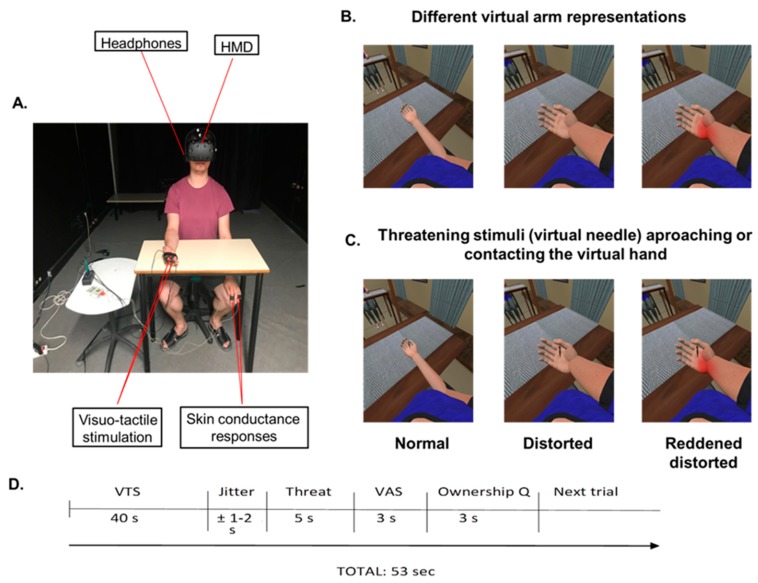Figure 1.
Experimental set-up and virtual arm and threatening stimulus conditions. (A) Participants wore a head-mounted display (HMD) that immersed them in a virtual environment. This allowed them to feel embodied in a virtual body, which they saw from a first-person perspective and which was co-located with their real body. Using headphones, participants heard the task instruction, “Pay attention to the right arm placed on the table, please,” before each visuo-tactile stimulus phase, which lasted 45 s. During the visuo-tactile stimulation, which was used to induce ownership over the virtual arm, virtual balls tapped the virtual fingers while participants felt, simultaneously, a tactile stimulation (vibration) on their real fingers. To record skin conductance responses after each threatening stimulus, two electrodes were attached to the index and ring fingers of the participants’ left hands. (B) Different virtual arm representations (virtual arm factor): normal representation, distorted representation (telescoped virtual arm), and reddened-distorted representation of the virtual arm. The distorted representation of the virtual forearm was shrinking within the virtual arm, as occurs with the telescoping effect in amputee patients. However, from a participant’s first-person perspective it seems bigger than the normal representation. (C) Threatening stimulus (virtual needle) in all three levels of the virtual arm factor. (D) Timeline of one experimental trial. Each experimental trial lasted around 53 s and was divided into four parts: First, participants were immersed in an immersive virtual reality (VR) environment in which the virtual arm could either be distorted, reddened and distorted, or in a normal position. To induce ownership over the virtual arm, they received 45 s of synchronous visuo-tactile stimulation. Second, after a jitter of 1–2 s, the threatening event appeared (a virtual needle) for 5 s. Immediately after the threatening event, the VAS appeared on the screen of the HMD. Finally, after the VAS was taken, a question related to ownership over the virtual arm appeared. VTS, visuo-tactile stimulation VAS, visual analogue scale; Ownership Q, ownership questionnaire.

